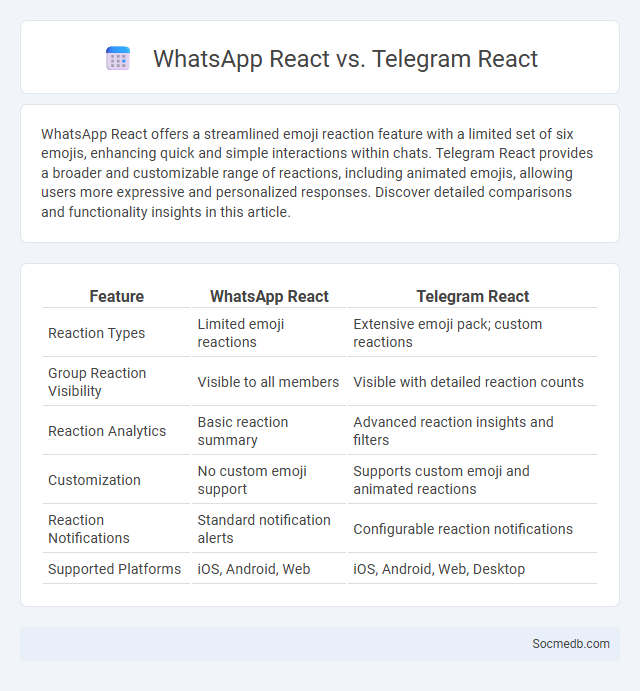
Photo illustration: WhatsApp react vs Telegram react
WhatsApp React offers a streamlined emoji reaction feature with a limited set of six emojis, enhancing quick and simple interactions within chats. Telegram React provides a broader and customizable range of reactions, including animated emojis, allowing users more expressive and personalized responses. Discover detailed comparisons and functionality insights in this article.
Table of Comparison
| Feature | WhatsApp React | Telegram React |
|---|---|---|
| Reaction Types | Limited emoji reactions | Extensive emoji pack; custom reactions |
| Group Reaction Visibility | Visible to all members | Visible with detailed reaction counts |
| Reaction Analytics | Basic reaction summary | Advanced reaction insights and filters |
| Customization | No custom emoji support | Supports custom emoji and animated reactions |
| Reaction Notifications | Standard notification alerts | Configurable reaction notifications |
| Supported Platforms | iOS, Android, Web | iOS, Android, Web, Desktop |
Introduction to Message Reactions in Chat Apps
Message reactions in chat apps enhance user interaction by allowing quick, expressive feedback without disrupting the conversation flow. Emojis and icons serve as intuitive tools to convey emotions, opinions, or acknowledgments instantly within social media platforms. Understanding how to use message reactions effectively can improve your communication efficiency and engagement in digital interactions.
What Are Reactions: A Brief Overview
Reactions on social media are interactive buttons allowing users to express emotions beyond simple likes, such as love, anger, or surprise. These responses provide valuable insights into audience sentiment and engagement metrics across platforms like Facebook, Instagram, and LinkedIn. Understanding reactions helps brands tailor content strategies to foster deeper connections and improve user experience.
WhatsApp React Feature Explained
WhatsApp's React feature allows users to quickly express emotions by reacting to messages with emojis without sending additional texts. This functionality supports real-time interactions and enhances conversation flow by providing immediate feedback in group chats and private messages. By integrating reactions, WhatsApp improves user engagement and streamlines communication on its platform.
Telegram React: Key Features and Usability
Telegram React offers a dynamic, user-friendly interface optimized for seamless messaging and enhanced group interactions. Its key features include powerful bot integration, end-to-end encryption for secure communication, and customizable chat themes to personalize user experience. The platform supports fast multimedia sharing and advanced search capabilities, making it ideal for both casual users and professional communities.
React to Messages: General Concept Across Platforms
Reacting to messages on social media platforms allows you to quickly express emotions or feedback using emojis, enhancing engagement without typing a response. This feature streamlines communication by providing immediate acknowledgment or sentiment, common on platforms like Facebook, Instagram, and LinkedIn. Utilizing reactions effectively can foster clearer interactions and strengthen connections across your digital network.
User Experience: WhatsApp React vs Telegram React
WhatsApp React offers a streamlined user experience with intuitive navigation and real-time message syncing that enhances your communication efficiency. Telegram React provides advanced customization features and robust security options, catering to users who prioritize privacy and personalized interfaces. Comparing both, WhatsApp excels in simplicity and widespread adoption, while Telegram stands out for flexibility and feature-rich interactions.
Customization and Emoji Options: Which App Wins?
Social media platforms vary significantly in customization and emoji options, with apps like WhatsApp and Telegram leading the way through extensive emoji libraries and personalized chat settings. Your choice depends on whether you prioritize unique emoji packs, skin tone variations, or custom chat backgrounds to enhance your messaging experience. Platforms constantly evolve, offering new customization tools to keep your interactions engaging and visually expressive.
Privacy & Security in Message Reactions
Message reactions on social media platforms enhance user engagement but pose privacy risks by exposing user preferences and interactions to unintended audiences. Ensuring end-to-end encryption and customizable privacy settings helps protect user data from unauthorized access and potential exploitation. Platforms that implement robust security protocols and transparent data policies strengthen user trust while mitigating threats related to message reaction visibility.
Impact on Group Chats: Cross-App Comparison
Group chats on platforms like WhatsApp, Facebook Messenger, and Telegram show distinct user engagement patterns influenced by interface design and privacy features. WhatsApp's end-to-end encryption significantly enhances user trust, leading to higher message retention and more active group participation. Facebook Messenger's integration with broader social networks facilitates seamless content sharing, while Telegram's support for large group sizes and customizable bots boosts dynamic interaction.
Final Verdict: Choosing the Best Reaction Feature
Selecting the best reaction feature on social media hinges on user engagement metrics, emotional range, and platform compatibility. Features offering diverse and nuanced reactions, such as Facebook's multiple emoji responses, boost interaction rates and foster more authentic expression. Prioritizing seamless integration with user interfaces ensures the reaction feature enhances communication without disrupting user experience.
 socmedb.com
socmedb.com